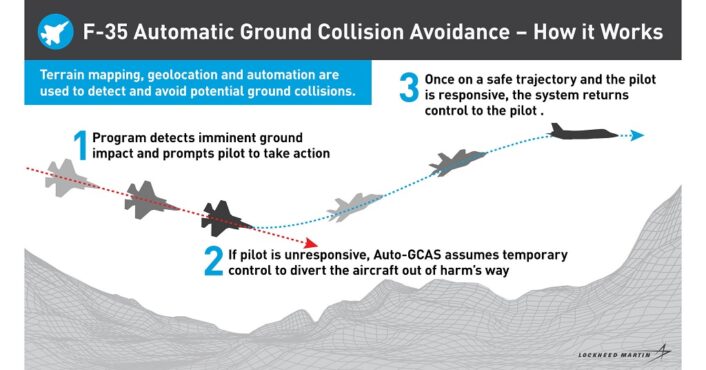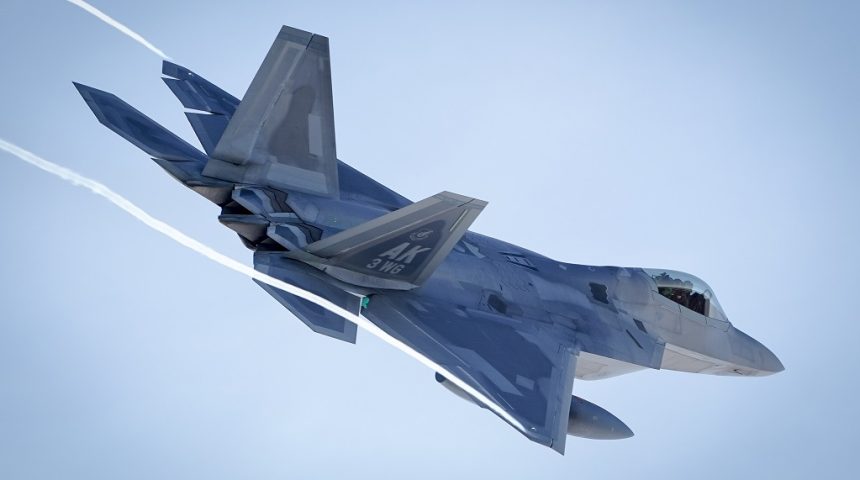The AGCAS system took over to recover the aircraft during three different events in 2016, 2020 and 2021.
In a story recently published on Popular Science, the U.S. Air Force Safety Center revealed, for the first time, how the Automatic Ground Collision Avoidance System (AGCAS) saved three F-22s and their pilots from crashing. Since it was first installed aboard fighter jets, the system has been now credited for saving 12 F-16s and three F-22s from crashing, with spatial disorientation being the most common cause for the dangerous attitude that triggered the automatic recovery.
Spatial Disorientation is the inability to determine one’s position, location, and motion relative to their environment. This can happen not only in fighter jets, but in every type of aircraft, both military and civilian. A situation that commonly causes Spatial-D is the flight in Instrument Meteorological Conditions (IMC), where bad visibility conditions would prevent a pilot from using external reference points and, in some cases, his senses would stop to “agree” with the current attitude of the aircraft. For an instance, the pilot’s senses could be tricked to think the aircraft is in level flight, while in reality it is in an inverted dive.
Recent news of a 12th #F16 pilot save from hitting the ground by #AutoGCAS. Add in this story of #Raptor pilot save. Can always rebuild a plane. Can never replace our sons and daughters. Auto GCAS continues to prove invaluable in our fleets. https://t.co/79g3fZ1TmU
— Billie Flynn (@billieflynn) April 25, 2022
As spatial disorientation already caused the loss of many aircraft and pilots, a first solution to counter the problem was found in the Pilot-Activated Recovery System (PARS). The functioning of the system is pretty straightforward: if the pilots recognize a Spatial-D condition, all they need to do is to press a button and the computer will take over the controls and recover the aircraft back to a safe attitude. This however still left space to cases where the pilots cannot determine if there is an ongoing spatial disorientation or where they are unable to initiate PARS, like with G-induced Loss Of Consciousness (GLOC).
To counter this problem, the AGCAS was introduced. Contrary to PARS, AGCAS provokes inputs to the flight controls automatically without pilot initiation. The technology relies on sophisticated computer software, terrain maps, GPS and predictive algorithms that will “take the jet” from the pilot when Controlled Flight Into Terrain (CFIT) is predicted to be imminent. The system is the result of a joint project of Lockheed Martin, NASA and the Air Force Research Laboratory.
AGCAS, however, is not installed on every fighter jet. The decision to equip all three fly-by-wire fighters jet models of the US Air Force first came about twelve years ago. The system was then intended to intervene if it calculated the aircraft was within 1.5 second of approaching a point of no return. According to the Air Force Safety Center, the system is currently installed on all active F-22s, almost the entire F-35A fleet and about two-thirds of the F-16s fleet.

Let’s now talk about the three events disclosed by the Air Force, beginning from the most recent one. This event happened over the Pacific Ocean on March 2, 2021, when an F-22 departed from Marine Corps Air Station Miramar, California, to practice Basic Fighter Maneuvers (BFM) with another unspecified aircraft. During the maneuvers, the pilot lost sight of the other aircraft and, while looking to find it again, the pilot inadvertently flew the aircraft into a nose-low acceleration toward the water, according to a summary of the incident by the Air Force Safety Center.
When the aircraft was 4,520 feet over the water, in a 42 degrees nose down attitude at a speed of about 800 miles per hour (about 700 knots), the AGCAS took over control of the F-22 and completed the recovery maneuver at an altitude of 1,730 feet. One of the most dangerous aspects of BFMs is that the pilot has to focus on the other aircraft to both safely maneuver without causing collisions and acquiring the target (as they say, “Lose sight, lose fight”), however this may also cause to lose situational awareness and possibly lead to Spatial-D. This is especially true for the F-16 and F-22 with their bubble canopies.
The second event happened in June 2020, when an F-22 departed Joint Base Elmendorf–Richardson, Alaska, and was flying in IMC before the pilot experienced Spatial-D. According to the summary, the pilot was focused on the situation display and over-banked the aircraft to 135° angle of bank, resulting in an inverted nose-down attitude, and began to accelerate rapidly. When the F-22 was at an altitude of 13,520 feet above sea level, with a speed of about 600 mph (520 kt), the AGCAS initiated the automatic fly-up and recovered the fighter jet at about 2,600 feet above the ground.
The third event happened over the Gulf of Mexico on December 6, 2016, when an F-22 pilot departed from Tyndall Air Force Base, Florida, experienced Spatial-D. according to the summary, the pilot did not recognize a nose-low attitude while rolling to 45 degrees angle of bank and descending below 2,000 feet MSL (Mean Sea Level). When the aircraft reached 1,540 feet above sea level, the AGCAS activated aural warnings in the cockpit and the pilot was able to recover the aircraft before the system took over controls. At that time, the F-22 was diving at an indicated rate of 9,400 feet per minute and the pilot completed the recovery at an altitude of 1,430 above sea level.
While the Air Force Safety Center considers all three events to be software-based saves attributable to the AGCAS, Lockheed Martin only considers the 2020 one to be definitely a save. This divergence of opinions appears to be based on a difference of data available to interpret the events as well as some software differences between different versions of the AGCAS.









